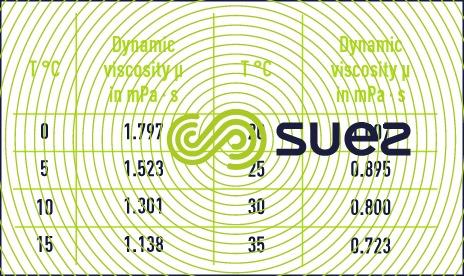
Viscosity is actually a measurement of internal friction, or resistance, to flow by external forces. All other fluids are then measured, calibrated, and thus compared to the viscosity of water. Water at approximately 70☏ (21☌) has an absolute viscosity of about one centipoise. Molasses and motor oil are thick or high viscosity liquids while gasoline and water are thin, low viscosity liquids. Thick liquids are said to have a high viscosity and thin liquids a low viscosity. Viscosity can also be thought of as a measure of the "thickness" of the liquid. Thinner liquids, such as water, have lower viscosities, while thicker liquids like oil have higher viscosities. Viscosity is the measure of a fluid's resistance to flow. Viscosity measurements are used in everything from lubrication and heat transfer fluids, to adhesives and coatings to aerodynamic and hydrodynamic drag. One of the more obscure and confusing parameters is viscosity. These behaviors are defined by a collection of measurements. Ns/m 2 is the unit of dynamic viscosity.There is a branch of science called Rheology that deals with the deformation and flow of materials. When the viscosity force is the only one that matters, dynamic viscosity is used. Dynamic viscosity is also known as absolute viscosity. It is unaffected by the presence of dynamic viscosity. In dynamic viscosity calculations, the shear stress to shear strain ratio is used. The symbol “η” is used to denote dynamic viscosity. The viscous force of fluid is represented by its dynamic viscosity. The other temperature in the state of gas that controls dynamic viscosity tends to rise as the temperature rises. As the temperature rises, the viscosity tends to fall quickly. Temperature fluctuations have an impact on viscosity. The higher the viscosity of a fluid, the higher its density and thickness. It is proportional to the density of a fluid. The m 2/s is the standard unit for kinematic viscosity.ĭynamic viscosity is the resistance that occurs when one layer of fluid flows across another layer of fluid. Kinematic viscosity is used when both inertia and viscosity forces are present. In kinematics, viscosity is also known as momentum diffusivity, and it is usually used to refer to kinematic viscosity. In terms of density dependency, kinematic viscosity is determined by the fluid’s density. Kinematic viscosity can be computed by multiplying dynamic viscosity by density. Kinematic viscosity is denoted by the letter “ν”. Kinematic viscosity is used to express both inertia and viscous force. The results of this test are only valid under particular circumstances, such as temperature. A fixed amount of fluid must flow over a known distance in a fixed amount of time to estimate the kinematic viscosity at the given conditions. For measurement, the capillary inside a calibrated viscometer is kept at a consistent temperature. Kinematic viscosity is a measurement of a fluid’s internal resistance when subjected to the gravitational forces of a planet.
#STANDARD VISCOSITY OF WATER IN PA S SOFTWARE#
Difference between Hardware and Software.Comparison Between Web 1.0, Web 2.0 and Web 3.0.Python | Difference Between List and Tuple.Difference between Clustered and Non-clustered index.Difference between Primary Key and Foreign Key.Difference between Structure and Union in C.Differences between Procedural and Object Oriented Programming.Differences between Black Box Testing vs White Box Testing.

Difference between comparing String using = and.Class method vs Static method in Python.ISRO CS Syllabus for Scientist/Engineer Exam.ISRO CS Original Papers and Official Keys.GATE CS Original Papers and Official Keys.


 0 kommentar(er)
0 kommentar(er)
